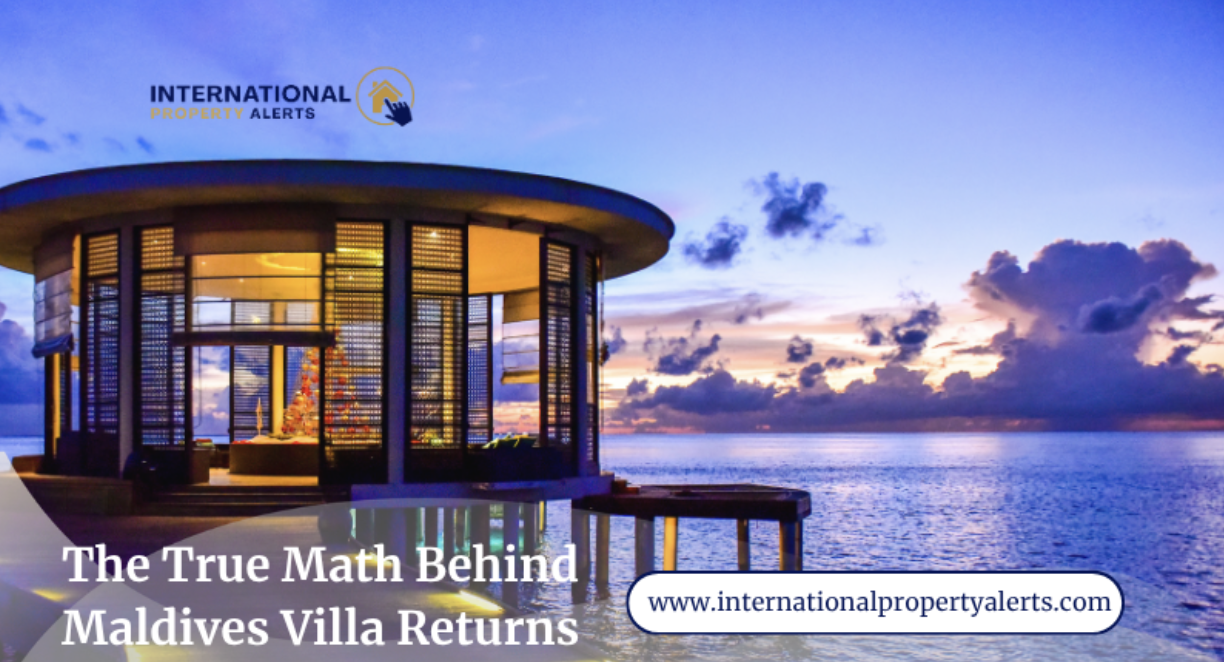The moment you step from the seaplane onto the powder-white sand, the scent of salt and frangipani lingers in the warm air. A gentle swell carries the turquoise lagoon into view, each crest catching the sun like a jewel. Here, on a remote atoll in the Maldives, every detail seems designed to suspend time. Beneath this sensory splendor lies a very precise calculation, one that turns daydreams of palm-fringed luxury into a structured, resilient investment narrative.
Island villas have long captivated the imagination. They promise privacy, exclusive service and a front-row seat to nature’s grandest show. Yet for the discerning buyer, the true question is not simply passion, but performance. How does a holiday rental on coral-lined shores translate into cold, hard returns? The answer lies in rental yield, a metric that connects nightly rates and occupancy percentages with acquisition price and operating expenses. For investors evaluating property for sale in Maldives, understanding rental yield is key to balancing lifestyle aspirations with sustainable financial performance.
Gross rental yield is the starting point. You divide annual rental income by the villa’s purchase cost, then express the result as a percentage. In the Maldives, well-appointed overwater or beach villas often command gross yields in the 5 to 8 percent range. But this simple figure masks the more nuanced story of net returns. To understand net yield, we factor in operational outlays: housekeeping, staff salaries, utilities, marketing fees and property management commissions, which can collectively total 25 to 35 percent of gross income.
Occupancy is the fulcrum on which net yield pivots. During the high season, from November through April, villas can achieve rates above 80 percent. Shoulder months still deliver strong numbers, with occupancy hovering near 60 percent. Even in the quieter summer months, the archipelago’s underwater world draws niche travellers—scuba enthusiasts, honeymooners seeking seclusion, families chasing cultural immersion—pushing occupancy into the mid-40s. When spread across the year, annual occupancy stabilizes around 65 to 70 percent, allowing owners to project reliable cash flows in their financial models. This consistency reinforces the Maldives’ reputation as a resilient international property destination with year-round investment appeal.
Maintenance is another crucial variable. The tropical climate demands vigilant care—regular fresh paint to combat salt spray, reinforced roofing against seasonal storms, underwater inspections to preserve jet-install docks and coral protection measures. Luxury resorts typically allocate 2 to 3 percent of the property value per annum to upkeep, ensuring that every villa sustains its premium appeal. When these costs are netted against gross revenue, the true annual net yield for Maldives island villas most often settles in the 4 to 6 percent band.
Enter Coral Residences, Maldives, a new standard of island living where sustainability underpins luxury. Conceived for the investor who seeks more than fleeting glamour, this collection of private villas marries cutting-edge environmental design with uncompromising comfort. Solar array systems and reef regeneration initiatives reduce operational overhead, nudging maintenance costs downward without sacrificing elegance. Here, the story of ROI is written in both financial statements and thriving coral gardens.
A comparative glance reinforces the Maldives’ competitive edge. Prime urban apartments in European capitals yield 3 to 5 percent gross. High-end holiday homes in Mediterranean hotspots hover around 4 to 6 percent. In the Maldives, when you align above-average nightly rates with the premium brand strength of Coral Residences, the potential for superior net yields emerges. Add to that the island’s reputation for tax neutrality on property income and the absence of capital gains duties, and you begin to see why this enclave commands attention.
Resilience is woven into the Maldives narrative. In the aftermath of global disruptions, the archipelago’s swift recovery underscored its appeal to an affluent, experience-driven demographic. By diversifying source markets—from Europe and Russia to China and the Middle East—the destination has buffered against season-specific downturns. Pre-bookings for the coming seasons already outpace historical averages, implying that stable occupancy projections remain intact.
Consider the hypothetical purchase of a beach villa priced at USD 2 million. At a conservative 65 percent occupancy and an average daily rate of USD 1,200, gross annual income approaches USD 285,000. Factor in a 30 percent operational cost and a 2.5 percent maintenance allocation, and net income settles near USD 175,000. That translates into a net yield of 8.75 percent on the equity deployed, excluding financing. Even with leverage factored in, the cash-on-cash return for many buyers can well exceed 10 percent.
Beyond pure numbers, owning a property in the Maldives delivers intangible dividends. Dawn light filters through floor-to-ceiling windows while turquoise waves lap against your private deck. Gourmet meals under a starlit sky, personalized spa rituals set to the rhythm of the ocean—these experiences engender loyalty and drive repeat bookings. The resulting brand equity feeds back into rental performance, creating a virtuous cycle of desirability and yield. For investors consulting a property for sale in the Maldives guide, these lifestyle and emotional factors are just as vital as financial metrics when evaluating long-term value.
One investor, drawn by economic pragmatism, discovered these layers of value firsthand. Having owned residences in London and New York, he sought a diversification play that combined strong tourist fundamentals with a more favorable cost structure. After a week at Coral Residences, witnessing the resort’s regenerative coral program and touring sample villas built to Passive House standards, he placed a reservation. His financial model, conservatively built, actually outperformed initial projections within the first two years.
For those who aspire to this refined island lifestyle and seek to cement their wealth in a robust, high-yield asset, Coral Residences presents a timely opportunity. In November, International Property Alerts will host a showcase event in Bangkok, offering an intimate forum to explore detailed financial models, meet the development team and arrange private consultations. It is the moment to step beyond aspiration and into deliberate ownership.
Feel the promise of future mornings spent ocean-side, the reassurance of a structured income stream and the pride of backing a project that respects both nature and luxury. To learn more or begin your ownership journey, contact us today and discover how you can secure your place in this Maldivian paradise.
Explore Coral Residences
https://internationalpropertyalerts.com/the-coral-residences-maldives-a-new-era-of-luxury-island-living/
Register for the Bangkok showcase event
https://offers.internationalpropertyalerts.com/coral-residences-bangkok-show
Join us in Bangkok this season for the Coral Residences Showcase, a rare opportunity to explore luxury island living and investment potential in the Maldives. Reserve your spot here: https://offers.internationalpropertyalerts.com/coral-residences-bangkok-show
Topic: How To Evaluate Rental Yields In Island Resorts

